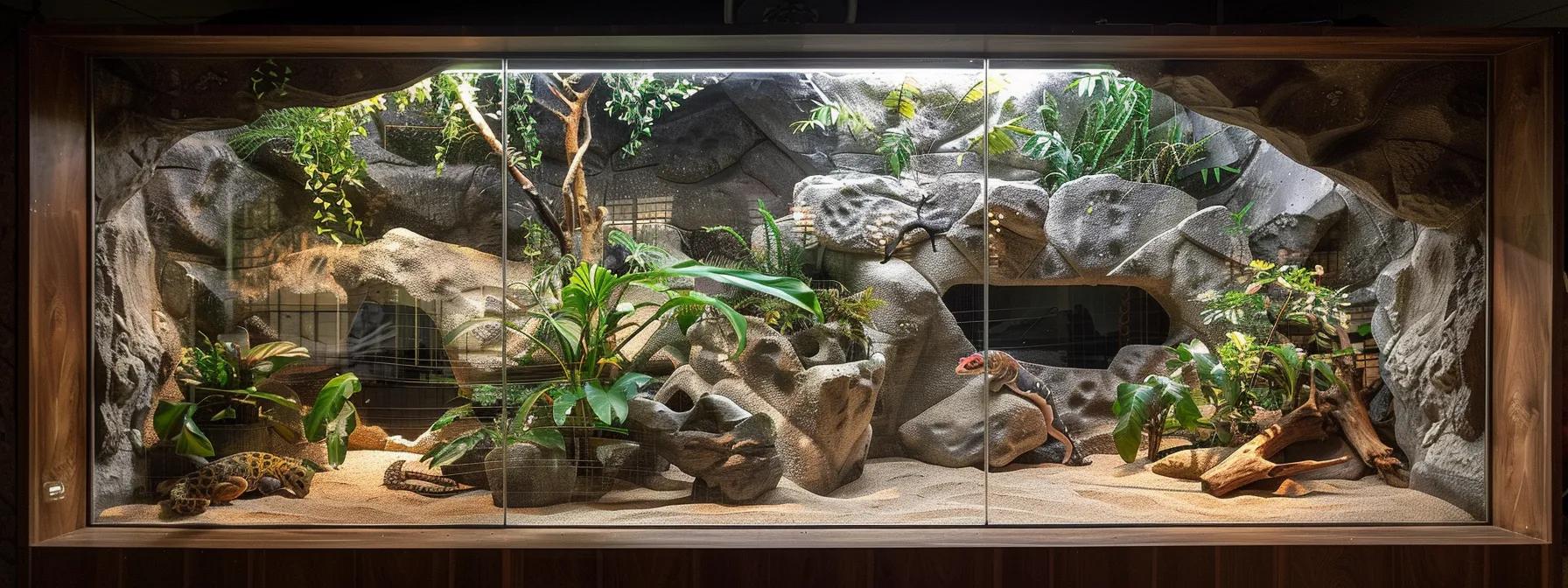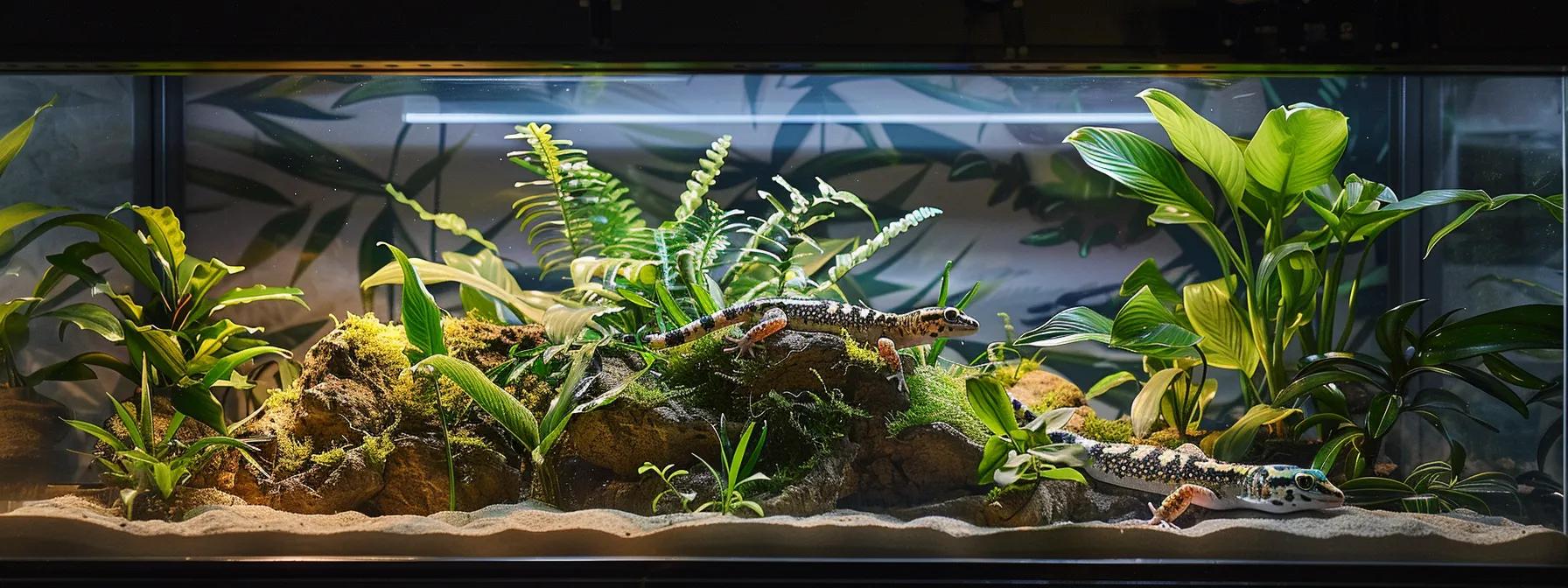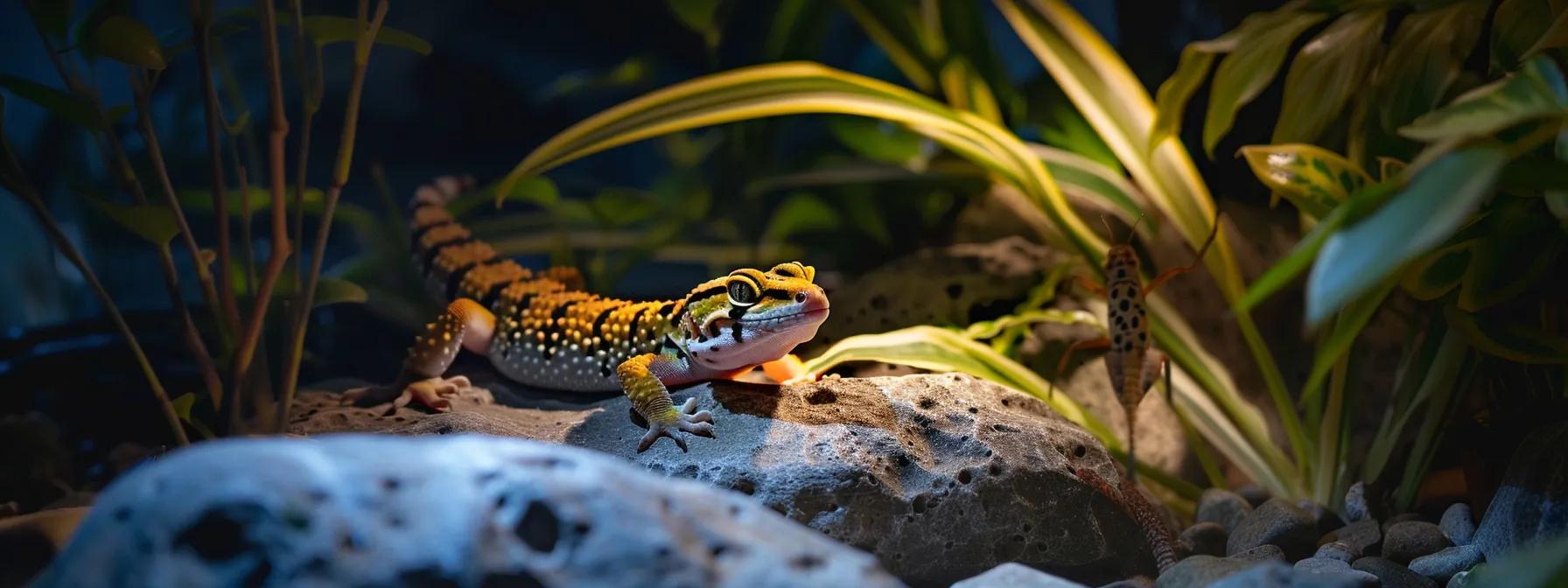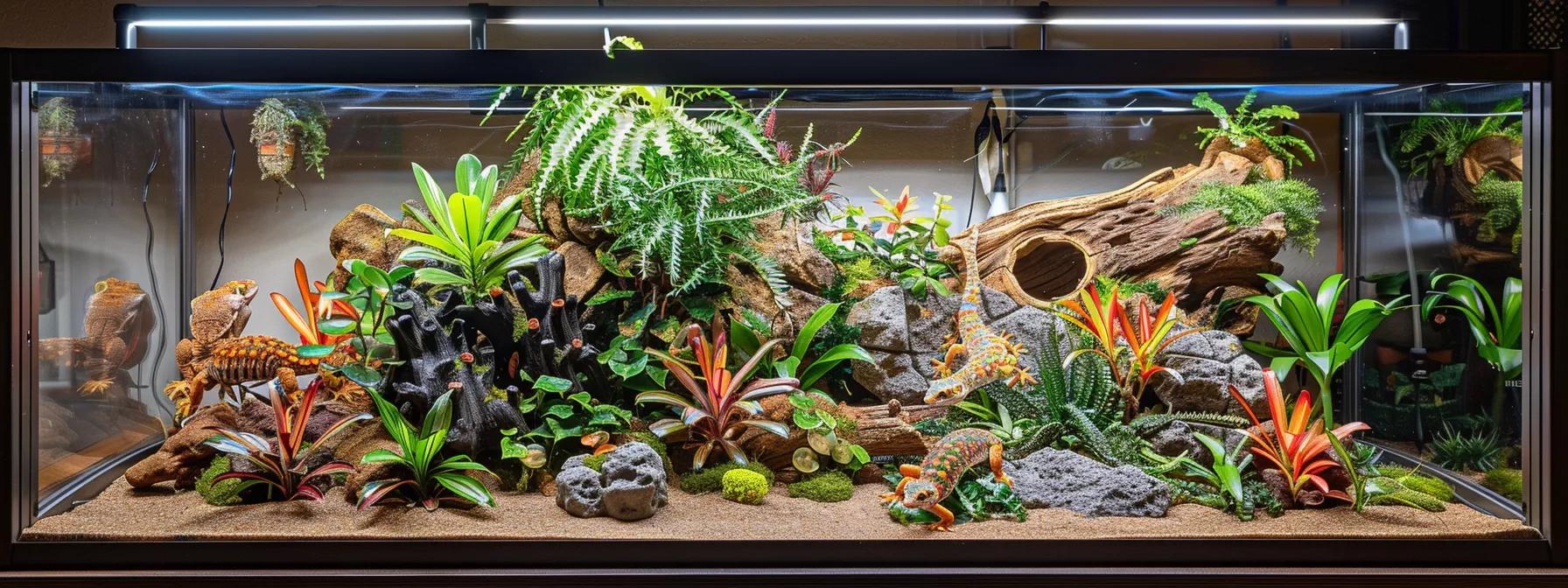
Leopard Gecko Habitat Requirements for Optimal Health
Creating an optimal habitat for leopard geckos is essential for their overall health, behavior, and longevity. These small, insectivorous reptiles, native to the arid and semi‐arid regions of South Asia, require carefully curated enclosures that mimic their natural environment. Designing a terrarium that meets the gecko’s spatial needs while replicating natural thermal gradients, humidity, substrate, and enrichment is vital. This article provides detailed answers regarding terrarium setup, heating and lighting, substrate and humidity, feeding practices, common health concerns, step-by-step habitat setup, and ongoing maintenance. By following these guidelines, pet owners can create a thriving vivarium that promotes natural behaviors and physiological needs, thereby preventing issues like metabolic bone disease (MBD) and dehydration.
With increasing popularity as exotic pets, leopard geckos require thoughtful attention to details such as heat mats, ceramic heat emitters, UVB/UVA lighting, and appropriate substrates like reptile carpet or paper towel. Proper décor such as hides and climbing branches also plays a crucial role in reducing stress and promoting exploration. The sections below address essential considerations for housing leopard geckos.
Transitioning now to the detailed breakdown, the first section centers on selecting the ideal terrarium and setup essentials.
What Is the Ideal Terrarium Size and Setup for Leopard Geckos?
Designing a homelike environment begins with choosing a terrarium that meets the gecko’s behavioral and physical needs. It should provide ample space for exploration, thermoregulation, and the inclusion of decor that simulates natural hideouts, thereby reducing stress-related behaviors.
How Large Should a Leopard Gecko Terrarium Be?
A single adult leopard gecko requires a 20–30 gallon terrarium. Typically, dimensions of about 20 inches long, 12 inches wide, and 12 inches tall are recommended. This size allows enough room for movement, thermal gradients, and varied substrate arrangements. Extra space is beneficial for breeding pairs or for adding multiple hides, climbing structures, and dedicated feeding spots.
The terrarium should include a warm basking area and a cooler zone so the gecko can adjust its temperature naturally. Common substrates such as reptile carpet, paper towel, or specialized mixes help mimic the loose, sandy soils of their native habitat. Adequate space also supports decor items like flat rocks, slate hides, and artificial vegetation that promote overall well-being.
What Types of Terrariums Are Best for Leopard Geckos?
Ideal terrariums offer secure lids, proper ventilation, and easy-to-clean materials. Glass enclosures with screen tops or hybrid plastic/glass models are popular for their durability and ease of observation. The screen tops facilitate airflow, reducing risks of fungal and bacterial infections and preventing excessive condensation.
Custom-built vivariums with integrated heating elements and UVB lighting mimic outdoor environments in controlled settings. Some designs allow for interchangeable substrate layers, such as inert soil or sand mixed with bioactive elements, which aid in adjusting temperature, humidity, and visual enrichment as needed.
Where Should You Place the Terrarium for Safety and Comfort?
Place the terrarium in a room with stable temperatures and indirect light, away from direct sunlight, heavy traffic, and loud noises. A sturdy, level surface such as a dedicated table or stand is recommended to ensure stability and proper heat distribution. Avoid areas with strong drafts or direct air conditioning vents. Consistent room temperature—ideally 70°F to 80°F (21°C to 27°C)—supports natural metabolic processes while reducing stress. The location should also allow easy access for cleaning without exposing the gecko to household chemicals.
How Do You Decorate a Leopard Gecko Habitat With Hides and Enrichment?
Hides and enrichment items are essential to comfort and stimulate the leopard gecko. Multiple hides should be placed both on the warm and cool sides to offer safe refuge. Commercial reptile hides made of slate, ceramic, or resin work well, and natural materials like cork bark and flat rocks can be used to simulate rocky desert terrain.
Additional enrichment through climbing branches, real or artificial plants, and shallow water dishes encourages natural exploratory and foraging behavior. A mixed substrate that includes bioactive elements such as sphagnum moss and rock dust further supports natural behaviors like burrowing while providing visual and tactile stimulation.
What Are the Heating and Lighting Requirements for Leopard Gecko Health?

Heating and lighting are crucial since leopard geckos are ectotherms that rely on external heat for proper metabolic function. A balanced thermal gradient and proper UVB/UVA exposure are necessary to promote digestion, activity, and prevent metabolic disorders such as MBD.
What Temperature Range Is Optimal for Leopard Gecko Habitable Zones?
A proper thermal gradient is essential. The basking spot should be maintained between 88°F and 92°F (31°C to 33°C), while the cooler area should remain around 75°F to 80°F (24°C to 27°C). This gradient allows the gecko to self-regulate its body temperature effectively.
Stable temperatures promote digestion and energy metabolism while preventing stress and issues with shedding. Using heat mats beneath the terrarium and ceramic heat emitters or basking bulbs above it helps maintain these conditions. Digital and infrared thermometers are useful for ensuring these temperatures remain consistent.
Which Heat Sources Are Best: Heat Mats, Ceramic Heat Emitters, or Basking Bulbs?
Different heat sources serve unique functions: • Heat Mats: Provide steady, diffuse heat from below without direct light. • Ceramic Heat Emitters: Offer consistent radiant heat that mimics natural sunlight without UVB output. • Basking Bulbs: Supply both heat and visible light, creating a localized hotspot for active thermoregulation.
Using a combination of these sources creates a multi-tiered thermal environment, ensuring an appropriate temperature gradient and allowing the gecko to choose its ideal spot. Regular monitoring with digital instruments helps adjust and balance these heat sources.
Why Is UVB and UVA Lighting Important for Leopard Geckos?
Although primarily nocturnal, leopard geckos benefit from low-level UVB/UVA exposure. These wavelengths support vitamin D3 synthesis, which is essential for calcium metabolism and bone health. Adequate UVB exposure may help prevent metabolic bone disease even if the gecko is not constantly active during the day. UV lighting also helps regulate the circadian rhythm, supporting normal sleep and feeding cycles.
Specialized, low-output UVB bulbs designed for nocturnal reptiles provide the correct exposure when used at the proper distance and duration.
How Should Heating and Lighting Be Installed for Safety and Efficiency?
For safety and efficiency, secure all heating and lighting elements as follows: • Affix heat mats with non-toxic adhesives or double-sided tape to the terrarium’s underside. • Mount ceramic heat emitters or basking bulbs securely on the enclosure’s lid or overhead fixture, ensuring they are far enough to prevent overheating. • Ensure wiring is neat and away from water or areas accessible to the gecko. • Regularly check temperature and humidity with digital thermometers and hygrometers, and use timers or controllers to mimic a natural day-night cycle.
This integrated setup ensures consistent heat output while preventing electrical hazards.
What Are the Best Substrate Options and Humidity Levels for Leopard Gecko Habitats?
Proper substrate and humidity control are key to mimicking the arid, desert-like conditions leopard geckos prefer. A safe substrate not only allows natural behaviors like burrowing but also prevents impaction and other digestive issues. Additionally, regulating humidity helps avoid respiratory and skin problems.
Which Substrates Are Safe and Recommended for Leopard Geckos?
Beginner keepers often use reptile carpet or paper towels because they are easy to monitor and clean. More experienced owners may opt for mixed substrates that mimic the natural habitat, such as organic topsoil mixed with washed play sand. Other options include ceramic tiles, slate, artificial turf, or vinyl flooring—all chosen for their ease of disinfection and maintenance.
For a more natural look, bioactive setups combine inert materials with a thin layer of leaf litter or dried moss, sometimes using small quantities of sphagnum moss or coconut fiber to locally boost humidity. The key is to select substrates that are non-toxic, non-abrasive, and minimize bacterial growth.
How Do You Maintain Optimal Humidity Levels in the Habitat?
Leopard geckos thrive in low humidity environments, ideally around 30–40%. To achieve this, use digital hygrometers for precise monitoring and ensure good ventilation using screen tops or adjustable vents. Regular spot-cleaning helps remove excess moisture from feces or food remnants. In bioactive setups, periodic substrate changes may be necessary to control microbial activity.
Occasional misting should be minimal and monitored carefully to avoid raising the overall humidity. Placing a shallow water dish away from primary heat sources allows the gecko to drink without affecting the enclosure’s temperature gradient.
What Are Bioactive Terrariums and How Do They Benefit Leopard Geckos?
Bioactive terrariums create a self-sustaining ecosystem by integrating live plants, beneficial microorganisms, and a natural substrate mixture. In these setups, a drainage layer of lava rock or expanded clay is combined with an inert substrate and a top layer of organic material. This arrangement promotes natural decomposition of waste, improves aeration, and reduces the frequency of complete substrate replacement.
The dynamic environment encourages natural foraging and burrowing behaviors while providing a stimulating sensory experience. It also reduces stress for the gecko by mimicking a more realistic, natural habitat.
How Should You Feed and Hydrate Your Leopard Gecko for Optimal Health?

Proper nutrition and hydration are crucial for maintaining a leopard gecko’s vitality. A balanced diet of live insects combined with nutritional supplements and access to fresh water supports healthy metabolism and prevents common health issues.
What Is the Recommended Feeding Schedule and Diet for Leopard Geckos?
Leopard geckos primarily eat live insects such as crickets, mealworms, and superworms. Juveniles should be fed daily, while adults can often be fed every other day. Feed portions should be appropriately sized—approximately the width of the gecko’s head—to prevent overfeeding.
Each feeding should include a variety of insects to ensure a broad nutrient spectrum. Dusting insects with calcium and vitamin D3 powder is essential for preventing metabolic bone disease. Occasional offerings of gut-loaded insects enhance nutritional value, supporting overall health.
Which Insects Are Best for Leopard Gecko Nutrition?
Crickets are widely recommended because they offer a balanced protein profile and are easy to gut-load. Mealworms and superworms provide energy-dense options, though care should be taken with superworms due to their higher fat content. Dubia roaches, with their superior protein and lower fat, offer an excellent alternative. Purchasing insects from reputable sources and maintaining proper hygiene ensures nutritional benefits.
How Do You Provide Clean and Safe Water for Your Leopard Gecko?
Leopard geckos require access to a shallow water dish that is refreshed daily. The dish should be made of ceramic or stainless steel to reduce bacterial contamination, and its shallow design prevents accidental drowning. Place the dish in an area where the gecko can easily drink but away from direct heat to avoid disrupting the enclosure’s temperature balance.
Regular cleaning and disinfection of the water dish are critical to prevent gastrointestinal and skin issues. Daily water changes and weekly thorough cleanings help maintain optimal water quality.
What Are Common Health Issues Related to Leopard Gecko Habitats and How Can You Prevent Them?
Improper habitat conditions can lead to several health issues in leopard geckos, including respiratory infections, metabolic bone disease (MBD), shed retention, and parasitic infestations. Timely recognition and proactive management of these issues are essential.
What Diseases Are Common in Leopard Geckos Due to Habitat Issues?
Improper humidity and ventilation can cause respiratory infections, signaled by wheezing or nasal discharge. Metabolic bone disease, driven by inadequate calcium intake or poor UVB exposure, may result in deformed limbs or soft bones. Unsanitary substrates can foster bacterial growth leading to skin infections or parasitic infestations. Monitoring behavior and physical changes in the gecko can help detect these problems early.
How Can You Recognize and Treat Metabolic Bone Disease (MBD)?
Signs of MBD include soft, deformed bones, tremors, reluctance to move, and issues with shedding. Immediate veterinary consultation is recommended if these symptoms appear. Treatment typically involves calcium and vitamin D3 supplementation along with habitat adjustments such as improved UVB lighting and consistent temperature gradients. Preventive measures—regular dusting of feeding insects, periodic habitat reviews, and proper lighting—are key to minimizing the risk of MBD.
What Should You Know About Leopard Gecko Shedding and Habitat Care?
Improper humidity or rough substrates can cause shedding difficulties, where patches of skin remain attached, often around the toes and tail. Maintaining the recommended humidity level (30–40%) and a smooth, appropriate substrate encourages complete sheds. If shedding issues occur, a gentle lukewarm water soak and careful assistance can help remove retained skin. Regular observation and cleaning help prevent infections linked to retained shed.
How Do You Set Up a Leopard Gecko Habitat Step-by-Step?

Setting up a leopard gecko habitat may seem challenging, but following a systematic process ensures all essential elements are addressed effectively.
What Are the Essential Steps to Prepare the Terrarium?
- Select and Clean the Enclosure: Choose a terrarium of appropriate size with secure lids and adequate ventilation. Clean it thoroughly with reptile-safe disinfectants.
- Plan the Layout: Decide on the placement of heating elements, water dish, hides, and substrate.
- Prepare the Substrate: Spread an even layer of chosen substrate (e.g., reptile carpet or a topsoil/sand mix) across the base.
- Arrange Decorations: Place hides on both warm and cool sides to create a thermal gradient; add flat rocks or slate for basking and climbing elements.
- Install Heating and Lighting: Secure heat mats, heat emitters, or basking bulbs and test temperatures in different zones using a digital thermometer.
- Place the Water Dish: Ensure it is shallow, easily accessible, and away from direct heat sources.
- Secure All Electrical Components: Confirm wiring is safely fastened and insulated to prevent hazards.
How Do You Install Heating and Lighting Correctly?
Attach heat mats using non-toxic adhesives under the terrarium and mount basking bulbs or ceramic heat emitters on the lid or overhead fixture, ensuring they are at a proper distance. Organize wiring to prevent contact with water or the gecko. Test device efficacy with digital and infrared thermometers, and use timers or controllers to replicate natural day-night cycles.
How Do You Arrange Substrate, Hides, and Water Sources?
Spread the substrate evenly, ensuring it is deep enough for burrowing without causing impaction. Position hides on both the warm and cool sides. Arrange natural décor items, such as flat rocks or logs, to simulate ground cover, and place the water dish where it is easily accessible yet secure from accidental spills.
A methodical approach to these steps establishes a stable, supportive foundation for a healthy habitat.
What Are Expert Tips and Best Practices for Maintaining a Healthy Leopard Gecko Habitat?
Long-term success requires continuous monitoring, periodic cleaning, and adjustments to maintain optimal conditions.
How Often Should You Clean and Maintain the Habitat?
Daily spot-cleaning to remove food remnants and waste is essential. A more comprehensive cleaning should be performed at least once a month by stripping the enclosure, disinfecting all surfaces, and replacing or refreshing the substrate. Maintaining a cleaning log with temperature and humidity readings can help track changes and identify issues early.
What Are Signs Your Habitat Needs Adjustment?
Watch for changes such as reduced activity, decreased appetite, abnormal basking, irregular shedding, or visible mold and condensation. Inconsistent readings from thermometers or hygrometers can also indicate the need for adjustments in heating, lighting, or ventilation, and should prompt a review of the setup.
When Should You Consult a Reptile Veterinarian?
If your leopard gecko shows signs of respiratory distress, weight loss, unusual behavior, or symptoms of MBD such as soft bones or tremors, consult a reptile veterinarian immediately. Regular check-ups, approximately every six months, can help detect and address minor issues before they become severe.
Final Thoughts
Leopard gecko habitat management involves selecting the right terrarium, establishing a balanced thermal and lighting setup, and maintaining proper substrate, humidity, and enrichment. Following the step-by-step setup and maintenance guidelines helps create a naturalistic, thriving environment that supports all aspects of the gecko’s physical and behavioral health. Ongoing monitoring and timely professional care ensure your gecko remains vibrant and active.
Frequently Asked Questions
Q: What is the most important factor when setting up a leopard gecko habitat? A: The most important factor is creating a balanced thermal gradient through proper terrarium size, heating, and lighting. A structured environment with designated warm and cool zones allows the gecko to self-regulate its body temperature, which is essential for digestion, activity, and overall metabolic function.
Q: How often should I replace the substrate in my leopard gecko’s terrarium? A: The substrate should be spot-cleaned daily, with a thorough replacement during a monthly deep clean. In bioactive terrariums, monitoring and partial replacement may suffice to maintain hygiene while preserving beneficial microbes.
Q: Can leopard geckos benefit from UVB lighting even though they are nocturnal? A: Yes, even minimal UVB exposure helps stimulate vitamin D3 production, which is critical for calcium metabolism. Controlled UVB lighting prevents metabolic bone disease while supporting a natural day-night cycle.
Q: What signs indicate that my leopard gecko’s habitat might need adjustments? A: Indicators include a decrease in activity, reduced appetite, irregular shedding, and physical signs like lethargy or the presence of mites. Inconsistent temperature or humidity readings, along with visible mold, also suggest that adjustments are needed.
Q: How do I ensure the heating elements in my leopard gecko’s terrarium are safe? A: Securely mount all heating devices, use digital thermometers to monitor temperature gradients, and ensure wiring is kept away from moisture. Regular inspections for wear and the proper functioning of timers or thermostats are also essential.
Q: Is it necessary to have both a heat mat and a basking bulb for my leopard gecko? A: Yes, a heat mat provides overall warmth while a basking bulb creates a localized high-temperature zone. This combination offers a natural thermal gradient that allows the gecko to choose its ideal spot for thermoregulation.
Q: What should I do if I notice signs of metabolic bone disease in my leopard gecko? A: Immediate veterinary consultation is required if symptoms such as soft or deformed bones, tremors, or difficulty moving are observed. Meanwhile, ensure the gecko’s diet is supplemented with calcium and vitamin D3 and verify that the UVB and heating systems are functioning correctly.





